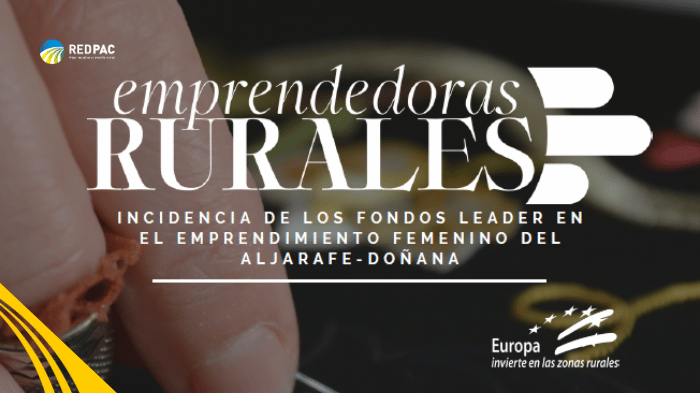
29 de February de 2024
The report is part of the Local Action Group's efforts to promote and raise awareness of female entrepreneurship in the towns within its areas of operation.
- “Rural Women Entrepreneurs: Impact of LEADER Funds on Female Entrepreneurship in Aljarafe-Doñana” is a document about the percentage of LEADER projects led by women since 2000 in the region.
- The analysis is part of the " Mentoring Project ", which aims to highlight the entrepreneurial capital of rural women in the area and analyze the current situation.
Supporting female entrepreneurship in rural areas has been one of the key objectives of the LEADER rural development program . Through this European initiative , "women's entrepreneurial capacity has been stimulated by providing them with a supportive framework for their business projects."
This is stated in the document “Rural female entrepreneurs: Impact of LEADER Funds on female entrepreneurship in Aljarafe-Doñana” , an analysis published by the Rural Local Action Group (GAL) Aljarafe-Doñana , which represents the region of Aljarafe-Doñana (Seville).
This report lays out in black and white the answers to a fundamental question on which the objective of supporting rural women entrepreneurs is based: Are the number of LEADER projects led by women in the region increasing?
Periods and comparison data
The report is part of the GAL's efforts to promote and showcase female entrepreneurship in the towns within its area of operation: the " Mentoring Project," which "has brought to light successful LEADER-linked initiatives that have been consolidated over time."
The report presents information by comparing various statistical and absolute data that refer to:
- Number of projects submitted .
- Percentage of women or women's organizations leading these projects.
- Executed projects, that is, those that have been completed.
- Percentage of women in those executed projects.
In order to make an adequate comparison of the “impact of LEADER funds on regional female entrepreneurship,” analysts have compared the four Rural Development Programs since 2000: PRODER-A and LEADER + (2000-2007 Framework) , LiderA (2007-2014) and LEADER 2014-20 (2014-2020).
Results
The main results show that during the PRODER-A period, 7.8% of the projects were from women or women's entities, a figure that increased to 16% in 2007 and to 22% in 2014. However, this percentage decreased to 16.5% in the 2014-2020 period .
Regarding this last framework, the report notes that the data is not yet final and that this period is proving to be "one of the most challenging in the history of the LEADER community approach."
Regarding this drop in female incidence from 22% to the current 16.5%, she points out that "it is proving particularly difficult to achieve a high gender incidence of LEADER funds within the current framework, in which, in addition to the problems related to the difficulties linked to programmatic management itself, the pandemic crisis and a subsequent multi-crisis scenario generated by various international conflicts have been added."
However, the GAL believes that, despite a situation that still segregates and hinders women entrepreneurs, they find "valuable female entrepreneurial capital in the region," and points to some factors that hinder opportunities for female entrepreneurship, such as a lack of social trust, difficulties in accessing financing, and work-life balance issues.
Financing
The LEADER funds provided for the presentation of the report are co-financed by the European Union's EAFRD fund , which contributes 90% of the final amount, and the Andalusian Regional Government .











